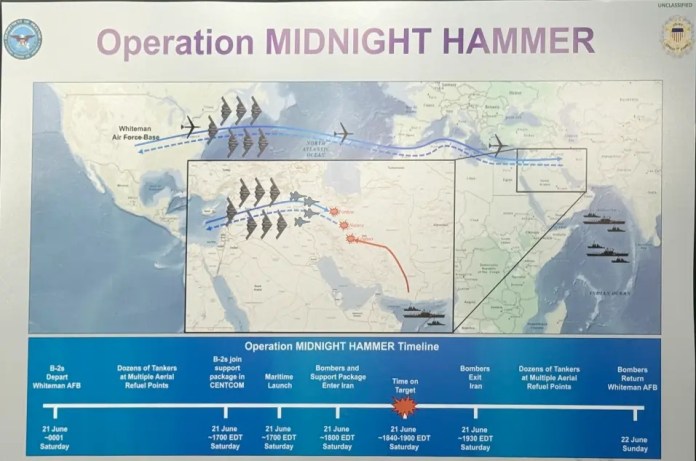

After United States launched a coordinated military strike on three of Iran’s most critical nuclear sites at Natanz, Fordow, and Arak, Secretary of Defense Pete Hegseth and Chairman of the Joint Chiefs of Staff Gen. Dan “Razin” Caine held a press conference from the Pentagon early Sunday morning to give details about the operation. They detailed how Operation Midnight Hammer was executed with precision and strategic deception, marking a significant escalation in the ongoing tensions between the United States and Iran.
“Last night, on President Trump’s orders, U.S. Central Command conducted a precision strike in the middle of the night against three nuclear facilities in Iran Fordo, Natanz and Isfahan in order to destroy or severely degrade Iran’s nuclear program,” Pete Hegseth said.
He added, “The order we received from our commander in chief was focused. It was powerful, and it was clear we devastated the Iranian nuclear program. But it’s worth noting the operation did not target Iranian troops or the Iranian people for the entirety of his time in office.” Hegseth said that the operation was “an incredible and overwhelming success.”
Giving details about Operation Midnight Hammer, Gen. Dan Caine said that the operation included the use of submarines, dozens of Tomahawk land attack cruise missiles, and it was the “longest B-2 spirit bomber mission since 2001.” He said that apart from dropping bunker busting bombs on Iranian nuclear sites, US also launched Tomahawk land attack cruise missiles against key surface infrastructure targets.
He said, “At approximately 5 p.m. Eastern Standard Time last night and just prior to the strike package entering Iran, a U.S. submarine in the Central Command area of responsibility launched more than two dozen Tomahawk land attack cruise missiles against key surface infrastructure targets as often as the Operation Midnight Hammer strike package entered Iranian airspace.”
The main strike was conducted by seven B-2 Spirit bombers that took from US and flew over the Atlantic. Notably, as a deceptive tactic, US also flew some B-2 bombers westwards over Pacific towards Guam.
Caine said, “On Friday midnight into Saturday morning, a large B-2 strike package comprised of bombers launched from the continental US. As part of a plan to maintain tactical surprise, a part of the package proceeded to the west and into the Pacific as a decoy, a deception effort known only to an extremely small number of planners and key leaders here in Washington and in Tampa.”

He said that the lead B-2 bomber launched two massive bunker-buster bombs at the Fordow nuclear site at 6.40 pm, and then the remaining bombers hit their targets. He added that the other targets were struck between 6.40 pm and 7.05 pm (US Eastern Time), and a total of 14 bunker-busting GBU-57 bombs were used. Therefore, the entire mission in Iran was completed in just 25 minutes.
Dozens of refuelling aircraft worked in tandem with the seven B-2 bombers to refuel them on the route. Fourth- and fifth-generation fighters, including F-22 jets, were used to clear the way for the airstrikes.
Caine added that Iran didn’t fire at the American planes, and the bombers and other jets returned home without any incident. “Iran’s fighters did not fly, and it appears that Iran’s surface to air missile systems did not see us throughout the mission. We retained the element of surprise,” he added.
Hegseth noted that this the first operational deployment of the GBU-57A/B Massive Ordnance Penetrators (MOP) — the most powerful heavy-duty bunker buster bomb known to exist. “Our initial assessment is that all of our precision munitions struck where we wanted them to strike and had the desired effect,” Hegseth said.
“It was historic, a strike that included the longest B-2 Spirit Bomber mission since 2001 and the first operational employment of the MOP, a massive ordinance penetrator,” Hegseth added.

















































